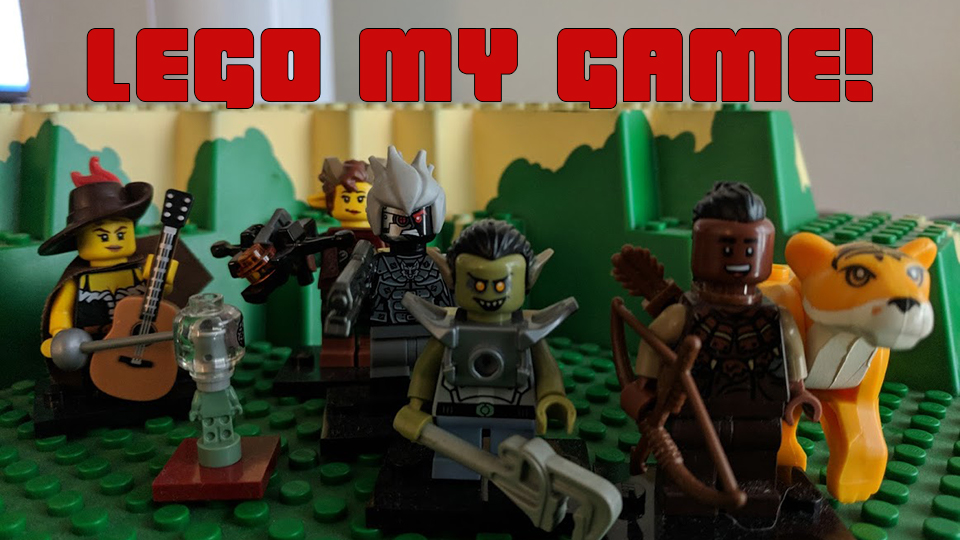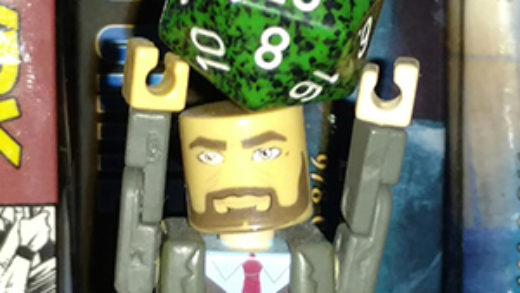Eventually some form of marker to determine character placement becomes important in a game. In a pinch, people use their dice or quickly drawn paper. Many tables use classic 28mm miniatures (in various states of painted) or printed cardboard standups. Others, like me, have found that what works best for our table are LEGO® or similar building bricks.

Lego In The Game
One of the reasons I prefer Lego is its versatiliity. No minifig or figure has to be permanent; characters can be evolving (with new heads, body paints, and gear) and retired items can be repurposed. While minifigs are bigger than the 28mm miniatures set as the standard for tabletop gaming dating back to Chainmail rules, they’re not so large they overpower any existing grid or map. Even in organized (aka society, league, guild, etc.) play, I bring a version of my character as a Lego minifig in my game and rarely is an eye batted.
As a GM, if I plan to use Lego as stand-in/minatures, I will make a “minifig build night,” part of the character creation plan. This can help some players better think about the visuals for their characters, as well as their equipment. While I don’t have every combination available, most players are able to use their imaginations to fill in any missing details. Rarely does a pre-sculpted miniature fit every detail of a character, either, as humorously detailed in an older Knights of the Dinner Table comic in which one of the characters attempts to find a one-legged dwarf thief miniature weilding a crossbow and wearing a ring on their finger.
Some GMs go further than minifigs and general props; they opt to use an entire dungeon map of Lego. This option is plausable and admirable, but can be costly. As mentioned, Lego minifigs are still within the realm of most miniature mapping scale, so can be used on standard gaming grid whiteboard or maps. If you have the resources, though, gaming with minifigs on brick-built maps can be a joy. (It can also be a pain if dealing with loose bricks, clumsy hands, or any other terrain-destroying feature like pets.)
Storage
While classic gaming miniatures, especially when painted, require individual piece storage in padding, Lego storage can be a bit looser. Purists, however, prefer to be as organized as possible. I have 6 16 quart storage tubs of Lego, organized by general piece type and often use plastic resealable bags to further organize. I’ve witnessed set-ups that organize each type of piece by color and take up basements and/or garages. Like any gaming additional, the level of care and organization will depend on a combination of personality and available space. For those who have both, organized storage will be key to quickly building a scenario or campaign.
Challenges
In addition to storage space, using Lego within a game can present some challenges. First and foremost, they are toys. There are some players who will be more interested in playing with the toys than playing with the games. While some people will become immune to playing with “their” toys others will find it a continual distraction. In these dire cases I suggest implementing the rule of “only the GM shall touch the minifigs/Lego.”
Lego, even the knock-offs, can become an expensive habit. While the time consumption of painting miniatures isn’t required, attempting to procure a library for future games can prove an a larger investment than expected. The solution I’ve found is to remember that any toys used are simply figureheads and don’t have to fully represent any items/creatures on the map and instead provide a scale and understanding of placement.
Online Resources
There are a number of places to view Lego in action in terms of gaming and to gather inspriation. I’ve started a general Pintrest board for some of the cool Lego sitings I’ve seen. Here are some sites that can direct relevance to using Lego in gaming.
- One of the best resources I’ve found was the “Lego Dungeons & Dragons” group on Facebook. This is a closed group (to avoid spammers), but they’re very friendly and helpful. Being a member also helped me discover some of these other great Lego for gaming sites.
- Studded Plate is a blog dedicated to gaming with Lego, with a great bestiary design resource.
- Lego Game Master is a blog of a fellow Lego-using GM who provides insight on their trials and ideas.
- Custom Minifig presents custom builds (often with unique sculpts and paints) that could be a resource or inspriation for character minfigs.
- Brothers Brick has a number of various Lego posts, and while some may not be relevant to gaming, many can provide inspiration.
- Reddit /r/lego and /r/legodnd both offer MOC (My Own Creation) builds that can be usable in gaming; the latter specifically focusing on using Lego in D&D (which can apply to other systems).
- Rebrickable provides designs and instructions based on combining sets and loose parts.
- BrikWars and Others is primarily a resource for using Lego in wargaming; as tacticals are shared between both wargaming and RPGs, BrikWars and its counterparts can be useful resources.
Building a Collection
Often, the toys gathered as children won’t be enough. While purchasing sets is a fine idea, it can be costly, especially when only trying to acquire certain pieces.
- Lego Pick A Brick is attached to the official Lego store and is a great way to find specific bricks when building a scene.
- Amazon.com Lego (Note: this is my affiliate link, purchases made from this link help pay for this site.)
- BrickLink is the eBay of individual Lego pieces, allowing users to buy just what the need/want.
- BrickArms provides custom, non-official Lego accessories and minifigs, helpful when more firepower options are wanted.
- Minifigures.com sells custom, pre-made minfigures, often offering paint jobs not available elsewhere.
- Minifig World does the same. There may be some overlap in options, but between the two, just about any minifig thought of is covered.
- MOCHUB provides not only custom instructions, but also the bricks needed for a those custom build.

Recent Comments